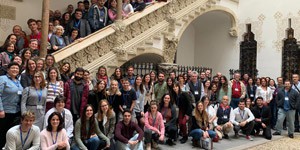At the beginning of July (30/06 - 05/07), the twenty-eighth annual symposium of the International Cannabinoid Research Society (ICRS) was held in Leiden, Holland, bringing together, as usual, the most renowned exponents of basic, preclinical and clinical research into the endocannabinoid system and the molecules that interact with it.
Fundación CANNA was one of the main promoters, along with the North American Drug Addiction Institute (NIDA), of the conference, in a panel including many leading companies in the sector such as the British GW Pharmaceuticals, Canadian Tetra Bio-biopharma and Tilray, the Dutch Bedrocan and the German Spectrum Cannabis, the main European subsidiary of the Canadian giant Canopy Growth.
Something old, something new, something borrowed
The first day began with a series of talks about the evolution of the cannabis plant and the chemical composition of the different varieties and chemotypes.
The inaugural speech was presented by John McPartland, an osteopath, an assistant professor at the University of Vermont and a collaborator of GW pharmaceuticals, who spoke about the geographic origins of cannabis and its centre of origin (COO) in Asia, based on pollen fossil records. These records do not typically differentiate between cannabis and hops (humulus) pollen, two closely related species that diverged 27.8 million years ago. McPartland and his collaborators used "ecological indicators", such as co-localisation with steppe plants (Artemisia, chenopodiaceae) to identify cannabis samples, and the presence of other types of pollen that suggested a forest environment, more favourable to hops. The oldest cannabis/humulus fossil pollen records in Asia date back to 19.7 million years ago and come from the northwest Tibetan plains, where steppe species replaced forests in the Eocene.
Back to the present, the following talks focused on different attempts to classify the different varieties of cannabis based on their chemical composition or genetic information. Sean Myles, from the Dalhousie University of Nova Scotia in Canada, presented a study in which more than 25,000 markers (SNPs) had been genotyped and 35 metabolites analysed in a sample of 149 cannabis strains collected in the Netherlands, classified as "Indica", "Sativa" or "Hybrid". After insinuating a mild correlation between individual terpenes (trans-β-farnesene in the case of sativas, mirceno and guaiol for the indica), he threatened to abandon the indica-sativa terminology to an audience that smiled knowingly between relieved and accomplice.
Mallory Loflin, from the veterans' hospital in San Diego, California, presented a different approach. Starting from a set of 106 samples from licensed cannabis dispensaries, and applying a statistical technique to construct predictive models called "principal component analysis", the researchers found three terpenic profiles that had a modest relationship with the indica/sativa/hybrid classification, which disappeared by eliminating a subset of seven cannabis samples. Finally, Alisha Holloway, from the company Phylos Bioscience, shared "the galaxy", a model for viewing genetic distance between cannabis strains of great aesthetic beauty, with the attendees. These efforts only highlight the enormous difficulties entailed in classifying cannabis based on its chemical composition and, according to the "retinue effect" theory, anticipating its therapeutic or psychoactive effect.
The highlight of the day was the presentation of the ICRS award for the entire career of Cecilia Hillard, a pioneer in cannabinoid research. Hillard began her research in the early 1980s and her laboratory has contributed more than 200 publications on cannabinoid interaction with the nervous and vascular systems, as well classifying endogenous ligands and their regulation. In an extraordinary conference about the functioning of CB2 receptors in the central nervous system, Hillard offered "something old, something new, something borrowed" reviewing more than 20 years of her career, from discovering this receiver in 1993 to current knowledge. Not by chance, many of the papers that preceded the award ceremony, as well as several posters, were focused on the efforts currently being made to elucidate the regulation and physiological relevance of CB2 receptors, as well as to value its usefulness as a therapeutic target in certain pathological processes. These include the over-expression of CB2 in microglia produced by peripheral inflammatory processes and the clinical data advocated by Divya Ramesh in which an interesting synergy with vanilloid TRPV1 receptors was perceived.
The final session was dedicated exclusively to cannabidiol (CBD), a cannabinoid that is rising in use due to the fact that it does not produce the cannabis poisoning characteristic of Δ9 -tetrahydrocannabinol (THC). As the culmination of several years of research by the pharmaceutical GW, a few weeks ago the American Food and Drug Agency (FDA) approved the first cannabis-based drug, epidiolex, an oral syrup containing 10% of CBD indicated to relieve seizures in paediatric refractory epilepsy syndromes such as Dravet and Lennox-Gastaut. The most interesting talks were given by Saoirse O'Sullivan and Sari Prutchi-Sagi. The first described a clinical trial (sweetPEA) in which the combination of CBD and palmitoylethanolamide (PEA) reduced the intestinal permeability caused by aspirin, indicating a therapeutic potential for intestinal inflammatory diseases. The second used CBD as a strategy for alleviating graft-versus-host disease, which occurs mainly after bone marrow transplants, when the transplanted immune cells attack the recipient's healthy cells.
Of mice and men
 Photograph courtesy of Ryan McLaughlin
Photograph courtesy of Ryan McLaughlin
The second day was dedicated to the endocannabinoid system's involvement in psychopathological processes and the development of the nervous system, both as a source of risk and as a therapeutic opportunity.
One of the most interesting talks was that of Ryan McLaughlin, an associate professor at Washington State University, about prenatal exposure to cannabis smoke. The use of cannabis during pregnancy is a growing concern for public health and the research presents serious limitations: longitudinal studies involve a great expenditure of time and money, it is ethically unfeasible to include control groups (placebo, double-blind, etc.) and there is no control over other variables such as the consumption of alcohol and other drugs, malnutrition or environmental agents. In an attempt to resolve these limitations, McLaughlin's group has developed a model in which animals can self-administer vapour so that researchers can control most aspects of the process. Using this model, McLaughlin and his students concluded that the mother's exposure to cannabis vapour in the final period of pregnancy produced THC levels with physiological relevance in the blood of foetuses. To study the relevance of this exposition on subsequent cognitive development, these animals underwent a battery of behavioural tests. Thus, animals exposed to cannabis before birth were able to discern between different visual cues and to "unlearn" a task for which they had been trained. However, they had greater difficulty adapting to changes in tasks and committed more failures than animals that had not been exposed. Although it is difficult to extrapolate these results in animals to humans, the team concluded that prenatal exposure to cannabis could affect the child's cognitive development in children and adolescents.
After the lunch break, Dr Daniele Piomelli of the University of California Irvine, editor-in-chief of the official magazine of the "Cannabis and Cannabinoid research" conference, presented the first of the two prizes for young researchers to Mario Van der Stelt, professor of molecular physiology at the University of Leiden. At the acceptance conference, Dr Van der Stelt focused on the chemical tools that have enabled research into the formation and degradation of endocannabinoids, mainly anandamide and 2-arachidonoylglycerol (2-AG), which are the molecules with which the body activates the same receptors as THC.
The day ended with a new round of "flash talks" in which eight authors who presented a poster that day had the opportunity to present a brief description (two slides) of the study and highlight their poster in the next session. Around 70 posters were shown in each of the three sessions held at the end of the day in which attendees had the opportunity to socialise with the speakers, mostly students, in a more relaxed atmosphere through the labyrinthine and warm corridors of the Leidse Schouwburg Stadsgehoorzaal.
Boat trip
The third day was an outdoor activity for all attendees: a boat trip on the Leiden canals almost to the sea. The morning talks focused on the control that the endocannabinoid system exerts on the immune system and the perception of pain. Again, palmitoylethanolamide (PEA), a molecule similar in structure to the endocannabinoid anandamide, and with which it shares synthesis and degradation pathways, focused attention on several presentations for its anti-inflammatory actions in animal models for arteriosclerosis, triple-negative breast cancer metastasis and chronic neuropathic pain.
Prior to the boat trip, Martin Kaczocha, assistant professor at Stony Brook University in New York, received the second prize for young researchers from the ICRS. In the last decade, Kaczocha's work has focused on one of the most controversial aspects of basic cannabinoid research: the existence of a specific transporter that transports anandamide to the inside of the cell for subsequent deactivation by the FAAH enzyme. His contribution has been critical in discovering that a family of proteins called "fatty acid binding proteins" (FABP) can act as "molecular boats" to transport compounds that do not dissolve in water from the cell membrane to other membranes inside the cell, thus saving the impediment represented by the cytoplasm, composed mostly of water. FABPs can carry out this intracellular transport function not only with anandamide and related molecules (such as PEA), but also with exogenous cannabinoids such as THC and CBD. The talk focused on strategies to exploit this type of protein, specifically FABP5, for treating pain, inflammation and cancer.
Smoke signals
The final day began with a session about cannabinoid interaction with drugs that are abused such as alcohol and opiates. A curious proposal that came from George Kunos's laboratory, about how blocking peripheral CB1 receptors blocked the voluntary intake of alcohol in mice through control over a hormone produced in the stomach, ghrelin.
The most interesting part of the day was focused on the series of lectures on clinical trials with cannabis. Some had a purely research aspect, such as the data on the changes in neurotransmitters during the THC poisoning presented by Natasha Mason of the University of Maastricht.
Ryan Vandrey, from Johns Hopkins University, presented a data collection tool to be used by doctors and cannabis patients to unify and harmonise the monitoring of these treatments to create, ideally, a large database. The battery of questionnaires was prepared by a voluntary committee of experts giving preference to those that were validated, concise, freely accessible and available in several languages. The interest in the presentation was great, considering the number of patients who are already taking a product that contains cannabis under the protection of different local, state or national jurisdictions.
Elisa Pabon, from the University of Chicago, presented an app still under development called "¿Estoy fumado?" (Am I high?), subsidised by the American Institute of Drug Addiction, which enables users to determine the degree of cannabis intoxication before getting behind the wheel.
Finally, Dr Maria-Fernanda Arboleda, from the Oncology Department at McGill University and collaborator of Santé Cannabis in Montreal, presented pharmacokinetic data about the absorption of "inhaled" cannabis by burning a cannabis pellet in herbal form, which contained 25 mg of THC and 5.5 mg of CBD, developed by the company Tetra Bio-Pharma. Although this term may refer to combustion smoke or the aerosol from a vaporiser, its use throughout the presentation seemed to deliberately hide that it was consumption by smoking, given the general consensus among the medical establishment to avoid this administration method.
The gala dinner in the church of San Pedro, the patron of Leiden, fantastically decorated for the occasion, brought an end to the ICRS symposium that, even though some regular attendees were absent such as Vicenzo diMarzo, Giovanni Marsicano and Beat Lutz, showed muscle and ability to face the generational change that is taking place after 28 years of being. On this occasion, the Spanish delegation was in charge of the groups of Julián Romero and José Martínez Orgado, president and treasurer respectively of the Spanish Society of Cannabinoid Research (SEIC), and of the Córdoba companies Vivacell Biotechnology and Phytoplant Research, in addition to the sponsorship of Fundación CANNA itself.


